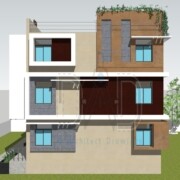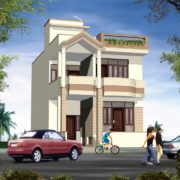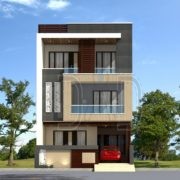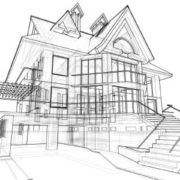Online Front Elevation Design Services | Home Front elevation design in India
Through the volume of space we move, see forms, hear sounds and feel it. These volumes need to be articulated in its own way to make it a complete and unique package. As space begins to be captured, enclosed, moulded and organized by the elements of mass, architecture comes into being.
There are ‘n’ number of combinations or ways in which we can design a building elevation with respect to the surrounding context and user requirements.
Following are some of the tips to make a best elevation out of your design or a building.
1.SHAPE, SIZE, COLOR, TEXTURE
Shape is the principle aspect by which we can identify and categorize a building. Also, size in terms of its physical dimensions is one of the most important characteristics in an elevation designs. Shape and Size of the elements define the proportion and visual aesthetics of the building.
Colour and Texture helps one to feel the aesthetics of a building. Colour sometimes can also contribute in defining the visual weight of the structure. On the other hand, texture can add little details and sense to the building surface.
2.POSITION, ORIENTATION, VISUAL INERTIA
Position of a form or an element is relative to its environment or visual field from which it is seen. Adequate positioning of elements can create a visual impact on an individual.
Orientation of the element is also important as it can add a different dimension and depth to the building elevation when placed or designed. Visual inertia is majorly connected to the pull of gravity that how the element behaving depending upon its geometry.
3.REGULAR AND IRREGULAR FORMS
Regular forms are those whose parts are related to one another in a consistent and orderly manner. They are generally stable in nature and symmetrical about their axes. Circle, Square, Triangle are basic examples of the regular forms. In contrast, forms that shows dynamic properties, asymmetry are considered as the irregular forms.
Regular forms add symmetry and balance to the structure whereas, irregular forms add dynamic effect to the building. Both types of form or elements can be used in building online home elevation designs depending upon the context, type of building and user requirements.
4.DIMENSIONAL, SUBTRACTIVE OR ADDITIVE TRANSFORMATION
When we talk about the dimensional transformation of an element, it means that the element is designed by altering one of its dimensions like length breadth or depth to create a visual frame or boundary around a particular surface in elevation. This further can be categorized into subtractive and additive transformations.
Subtractive transformations are basically designed while planning process such that the void of regular or irregular form is created in a volume which creates a unique elevational language.
Additive forms are basically the add-ons to the building surface to articulate the façade after the design is complete. Majorly use additive forms is preferred in standard house designs as the user want to use maximum land area of the land which he owns. These forms can either be regular like a rectangular frame or can be irregular as any polygonal shape. D Architect Drawings Platform provide you latest home elevation design in india and floor plan, 3D, 28*40 house map maker online, home front elevations design in india for your dream home.

5.EDGES AND CORNERS
Corners define the meeting of two planes. If two planes simply meet and the corner remains unadorned, the corner will have a sharp-edged look. The corners and edges of the elements with which the elevation is going to be designed can vary differently like, it can be a chamfered edge, rounded edge, edges with a gap etc. Different treatment creates a different visual impact.
Edges and corners in elevation should be designed in such a way that the building should look as one when seen from the corner side. Also, they should not hamper the structural integrity of the building.
6.SURFACE ARTICULATION
A surface of the house or a building can be treated in different ways as per the requirement and aesthetics of the building. A surface can be articulated with the help of a different material or can be articulated with paint or even just the window openings and its design.
These articulations if having any depth can also create a different light and shade effect on a building or a house.
7. SYMMETRY, BALANCE
Elements or forms that are designed to create an elevation of a house or any building can very well define the symmetry and balance of the structure. Sometimes even if the plan of the house is mirrored or symmetrical; elevation need not be symmetrical and vice-versa.
Symmetry itself creates a visual balance in the elevation of the structure. Also, balance of a bigger element in elevation can be achieved by creating a smaller complex element on the other side.
Balance is one the most important factors considered while designing any house elevation.
8.REPETITION, HIERARCHY, RHYTHM
Repetition of several forms or elements in elevation creates a different language for the online elevation designs of the same building. Sometimes use of these repeated elements can create a rhythm in an elevation increasing its aesthetical value. Repeated use of windows in a surface also creates a different kind of rhythm in façade elevation.
Rhythm also can be achieved using different kind of materials or colours or textures. It can also be found in the height of the building i.e., in the different volumes of a building from exterior.
Hierarchy can be seen in elevations by the use of same elements repeatedly but in a different dimensional size ; thus creating a rhythm also.
9.USE OF DIFFERENT MATERIAL PANELS / JAALIS
In some of the cases as per the economic conditions and user requirements; use of jaalis or perforated walls can be seen in elevation just to create a traditional effect and elevation more dynamic. Also, use of different material panels like concrete panels, wooden/MDF panels etc., can be seen in many of the designs of the houses or buildings.
Briefly, we can conclude that the elevation of a building majorly depends upon the context in which it is build. Secondly, economic conditions and user requirements and creativity of the designer or an architect. Best home Front Elevation Design in India with top home front elevation designers. If one needs to buy 14×60 house plan, 28*40 house map maker online then contact us immediately.
If you are looking for the best home front elevation design in india, for your home then d architect drawings is right place for you.We are one of the best front home elevations design in india that provides attractive designs for your dream home. Find here front elevation of indian house 30*40 sites, buy 14×60 house plan, 28*40 house map maker online etc.











